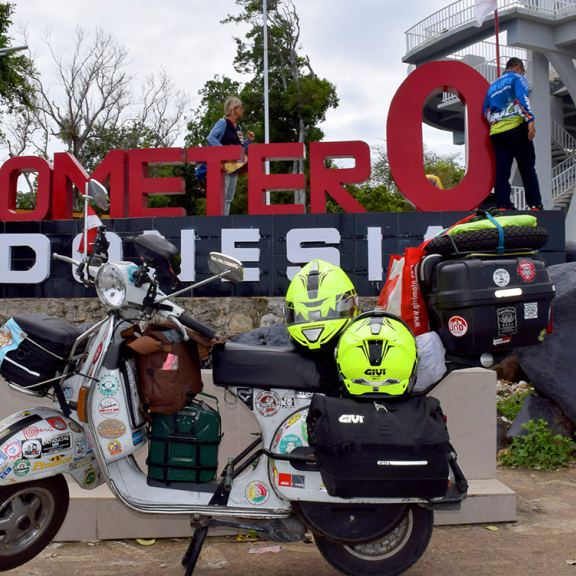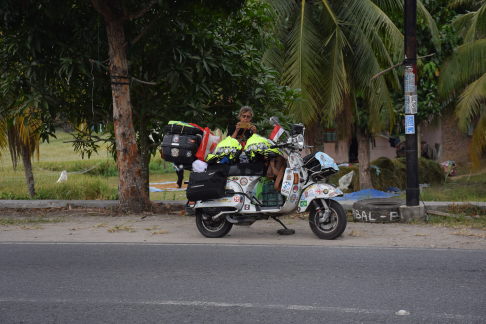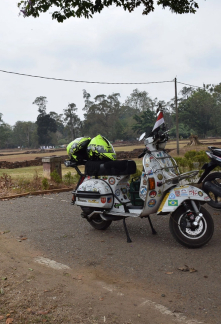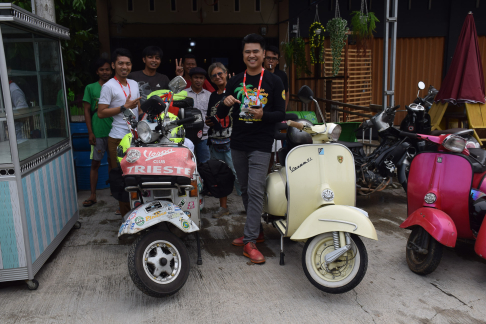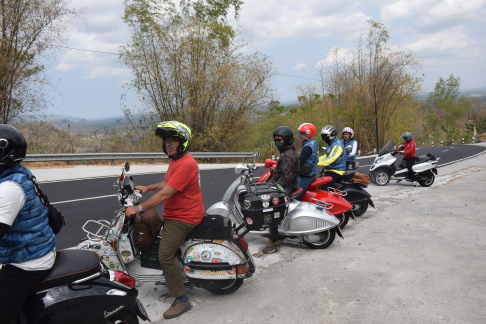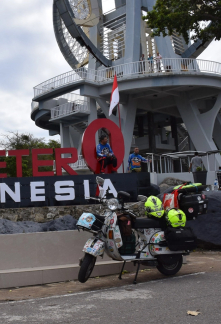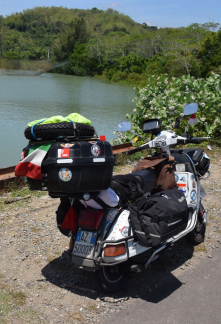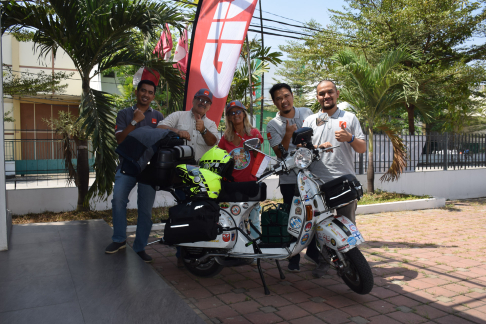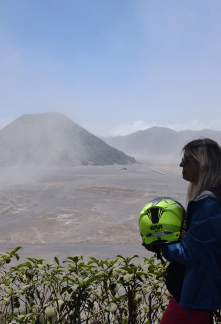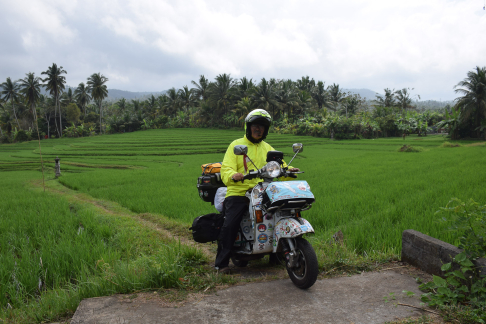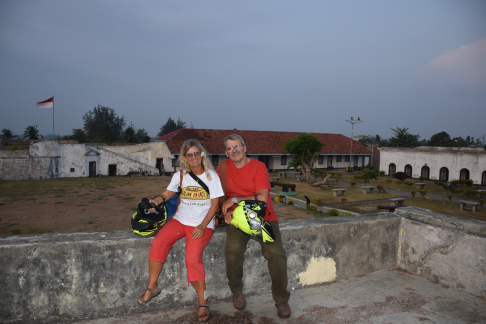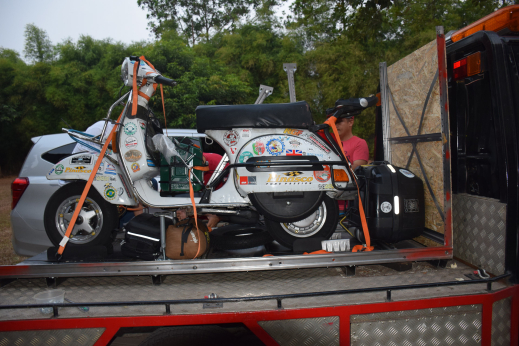Touring Indonesia by Vespa
Touring Indonesia by Vespa
We completed the first part of our trip in October 2019, after almost a month and a half on the road, crossing the islands of Sumatra, Java and Bali, where we left our Vespa. The second part was scheduled for May 2020, starting in Bali, crossing the Sunda Islands of Timor, Sulawesi and Borneo before returning to Bali for the Vespa World Days 2020 event, and then returning to Italy. Unfortunately, Covid upset our plans.
But let’s return to the journey that we did complete, full of excitement and wonderful encounters throughout.
Once we had packed the shipping crate and obtained the Carnet de Passage en Douanes documentation for the Vespa, it was sent by air to Jakarta, our starting point.
We managed to find a flight at an excellent price and got our visas on arrival at the airport, valid for one month with the option to renew them for another. After all, when travelling by Vespa, anything can happen.
We stayed in the capital for three days, visiting the city and meeting various people who we had been in contact with for years, such as Dodit and Bagus. Together with the Vespa club, we explored the city by night.
That’s right, by night! Vespa riders in Indonesia drive mainly at night because by day the traffic is so heavy (millions of motorbikes, cars, buses and trucks are on the move) that it takes at least two hours to travel from south Jakarta to the north of the city.
Finally the day to collect our Vespa from customs arrives. We are very pleased to see it and start our journey, also because we don’t have that much time available, just over one month, but we still don’t realise quite what is ahead crossing the island of Sumatra. Custom’s procedures are quick and everything runs smoothly, thanks to the help of Indra, an Indonesian friend who we have been in contact with for a long time and who knows how to navigate the terrible local bureaucracy.
We arrive at the home of our friend, Abraham, who is hosting us, check there is no damage to the Vespa, connect the battery, top up the oil and petrol, start the engine and go for a drive around the house.
The next morning at 8 a.m. our journey begins. It takes us almost two hours to leave the city and reach the periphery, where we head off in the direction of Sumatra and take our first stop at Cikupa, where they are expecting us at the Givi Indonesia factory. The reception staff are welcoming and offer us something to eat and drink, making us feel immediately at home. Their curiosity is evident and they take plenty of photographs and selfies. Before setting off, they give us two rain suits, two caps and two shirts and tell us that they will let the bikers know about our arrival in Sumatra.
At midday we say our goodbyes and set off again towards the ferry for Sumatra. This is about 100 kilometres away but in Indonesia it is illegal for two-wheeled vehicles to drive on the motorway, so we have to stay on roads crossing densely populated and trafficked areas.
At 3 p.m. we reach Merek, the small town from which ferries to the island of Sumatra depart. Luckily, we find an executive ferry — much faster than the standard vessels — board almost immediately, and at 4 p.m. begin the crossing which lasts just over ninety minutes.
On the ferry, we make friends with a group of bikers from Gorontalo on Sulawesi, who, intrigued by our Vespa, take hundreds of selfies with us and our wonderful vehicle. It turns out that we have a common destination: kilometre zero of Indonesia, on Weh Island.
We arrive at around 5:30 p.m. and immediately discover one of the key challenges in Sumatra: it is already dark at 6 p.m. and driving on these roads after dark is very dangerous, due to road quality, animals crossing and crime.
This has a big impact on how we travel. We had planned to cover 250–300 km per day, but we soon realise that here on Sumatra distances are calculated in time, not kilometres.
In fact, due to the intense truck and car traffic, and the potholes and damaged road surface, our 300 km per day soon become 12 hours of travel, the number of daylight hours.
We set off with the intention of getting to Bandar Lampung but it is soon dark and we have to stop at the first town we come across along the road, Kalianda.
Driving on Sumatra proves to be highly challenging, and it takes us seven days to travel 1,800 km and reach Medan, the island’s capital. On three different occasions along the way we risk being hit by trucks and buses veering into our lane without slowing, passing within centimetres of us.
Although driving on the island of Sumatra is very difficult and dangerous, the warmth and affection of the people we met along the way more than made up for the hard work and hours of travel, often under a searing sun or in driving rain. We don’t know exactly how many Vesper riders/bikers we met along the road and in each city we came to, but we can say without a doubt that these are truly wonderful people, willing to wholeheartedly share everything they have. They waited for us along the main road, perhaps just to say hi or take a few selfies together to post on Instagram. When we stayed in a town for the night, they took us to visit the most beautiful and traditional local monuments, experienced uniquely on two wheels.
We met many bikers and Vespa Clubs, and in Jambi they even invited us on stage to speak about ourselves at an important meet-up. We posed for an unbelievable number of photographs and selfies, they interviewed us and featured photos and articles about us in the newspaper. Basically, we were treated like stars, although we were the first Italians to set foot on Sumatra with an Italian-registration Vespa.
Between dances, selfies and stories, we finally reach the fulcrum of our adventure and the goal we had set ourselves: to get to kilometre zero on Weh Island.
Kilometre zero is the most north-western point of Indonesia, marked with a tower that has become one of the most popular goals for Indonesian and foreign bikers. We leave Medan, following the AH25, which leads to the border with the Aceh province, continuing on to the city of Langsa.
The road is in good condition, still with potholes but a bit less frequent. It takes us two days to get to Banda Aceh, the capital of the region, but it is a walk in the park compared to the previous days. In the wake of the devastation caused by the tsunami on 26 December 2004, the majority of roads were rebuilt and limitations were placed on heavy vehicles, a welcome surprise for us.
In Banda Aceh, the western-most city of Indonesia, we are met and taken to visit the tsunami museum and a ship that the tsunami carried right to the centre of the city. This is a fascinating experience that gives us a glimpse of the scale of this disaster that locals had to face.
At 7 a.m. the following morning we board the ferry that will take us to Pulau Weh, from where we will proceed to kilometre zero. We are excited to reach another challenging target to add to our list and this time we are the first Italians on an Italian vehicle to reach it.
The road is very narrow, thirty kilometres of continuous rising and falling, with curves and winding bends, but it is all worthwhile. Once we reach the great tower, I park up in front of the large sign with the wording “Kilometer 0 Indonesia”. We only stay one day to visit the island and its beaches, spending the night in a hotel in Sabang, a fishing town and administrative centre. At 7 a.m. the next morning the ferry sets off for Sumatra.
Having returned to Banda Aceh, we head straight off. We have to take the same road as on the outbound journey to return to Medan. We make a stop in Langsa on the way, a city in Aceh where, aware of our arrival, the mayor wants to meet us to officially present a plaque marking our visit. We are lost for words but have learnt that Indonesians are extremely welcoming and friendly people.
The journey continues, and we stay in Medan for two days to pick-up our documents before taking the mountain road that will lead us to Lake Toba and Samosir Island, at the centre of Sumatra. The roads are increasingly difficult but there is less traffic. We are crossing forested areas and we only encounter small villages.
Lake Toba is a resort-style destination but there are very few tourists around. We stop in the village of Tuk Tuk, a small settlement at the end of a promontory where there is always a fresh breeze, the water reflects the surrounding mountains like a mirror and for a moment you can forget that you are near the equator. The next day begins with another ferry, this time to Parapat. We continue along a poorly maintained road, but with little traffic, which crosses Sumatra towards the west coast. There are innumerable potholes, emergency bridges covered with boards, sections of dirt track and steep climbs followed by sudden descents that really test the brakes on the Vespa.
We have many kilometres to travel to reach Jakarta, crossing a huge section of jungle; constantly rising and falling, it’s a roller-coaster ride. On the way, we visit Paramian, Padang, Bengkulu and Bandar Lampug. In all of these places, there are large groups waiting for us, like Andi and Indra, who are anxious to accompany us even if just for a few kilometres.
After almost 6,800 km of travel we are back in Jakarta, and after a few days relaxing we leave the capital and its impossible traffic, convinced that won’t find anywhere so chaotic… but we are wrong!
When we arrive in Bandung, the chaos on the roads is even worse and I have difficulty driving in the never-ending flow of scooters. I am very pleased that the engine prepared by Pinasco holds out without a sign of problems; it’s a real gem.
Having arrived in Yogyakarta, before taking part in the Indonesia Scooter Festival, we visit the two archaeological sites that have made the city famous, the temples of Borobudur and Prambanan.
There are ten thousand Vespas at the Scooter Festival, and we are one of the attractions of this strange circus, made up of people as strange as they are amiable. The motto of Indonesian Vespa riders is “Satu Vespa Sejuta Saudara”, which means “One Vespa, a million brothers” and I must say that this is really true for them. We were guided on this journey by innumerable Vespa riders who showed us where and how they lived, for a truly unique experience that will always remain with us.
Once we reach Malang, the city at the base of volcano Mount Bromo, I decide to go off-plan and cross the crater of the volcano, known locally as the “sea of sand”, to reach the city of Probolinggo on the Madura Strait, East Java.
This will be a truly challenging route, rising with gradients up to 30% to the summit of the volcanic cone before eleven kilometres of ash and sand to cross it. The guys from Malang guide me but they are travelling light, while I have lots of baggage. After nine kilometres, the Vespa enters the sea of ash up to the footplate, and I am stuck. Nearby there are several guys with scooters that seem to be waiting for us, and it turns out they are. They know that people get stuck in this point and offer us help to resolve the problem.
The Vespa is loaded and tied to a small rack on a scooter, and the bags to another, while I get on the third. In a few minutes, we are on our way again at full speed. These locals fly over the ash despite the load. Their large wheels sink but they never lose control. In less than fifteen minutes, we are on the other side of the crater, where they unload the Vespa, asking me for a very modest fee. I say goodbye to everyone and start the long descent that takes me from 2,000 metres altitude down to sea level.
After 38 days travelling, we arrive on Bali, where we are met by Eka Yana, a Balinese friend who will look after our Vespa at his home until our return in 2020… but unfortunately due to Covid our Vespa World Day Bali 2020 still hasn’t come.
It was a challenging journey because we had overlooked certain factors such as the short daylight hours and road quality: nine thousand tiring but fantastic kilometres.
Fortunately, the kit provided by Givi was extremely useful. The beautiful fluorescent modular helmets, waterproof cargo bag, intercom, Garmin holder and above all the side bags, also waterproof and the perfect size for this trip, all helped us to transport our luggage comfortably and safely.
Sumatra, the island of smiles, new faces and great emotions, will remain in our hearts forever. It was hard work, with many risks, but now we have many new friends and adopted sons and daughters, because to the children on Sumatra we are Mum and Dad now.
We would recommend this trip to anybody, and particularly those who want to experience the culture of a place when they travel… we are looking forward to our next departure!
The protagonist
Mario and Sandra
The protagonist
Mario and Sandra
A couple of passionate travellers, they love to travel around the world on their Vespa
Motorcycle equipment
long motorcycle journeys
GIVI offers an extensive range
of motorcycle touring accessories
GIVI offers an extensive range
of motorcycle touring accessories

